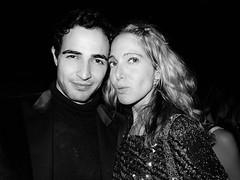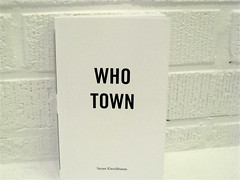Tonight at 6 p.m. at the Bowery Poetry Club, Susan Kirschbaum will read from her debut novel, “Who Town.” The book is drawn from Ms. Kirschbaum’s experiences over the past 15 or so years in New York: after moving from a middle-class Philadelphia suburb, she covered the downtown scene for The Times, The New York Observer, The Huffington Post and others. Now in her late 30s, Ms. Kirschbaum is the rare reporter who became part of her stories, dating band members and artists and hanging out with the crowd she was supposed to cover. She told The Local about her downtown-centric writing life, and how Candace Bushnell, the author of “Sex and the City,” started it all.
When you came to New York, what was the Lower East Side and East Village scene like?
I got to New York in the late ’90s, when the Beahver parties were raging at Don Hills and junkies still roamed Alphabet City. A lot of young artists still lived in the East Village and bars like 7A and 2A raged late at night. I also remember going to poetry slams in Tompkins Square Park. And I was writing for a magazine called Cups, not a tits rag, but a publication dedicated to “coffee culture.” The office was on Ludlow Street. But then only a few trendy boutiques – hat stores and Tony Melillo – had popped up. Mostly, the area was still filled with Jewish haberdashers and discount leather stores. Just about that time, the investment banker yuppie types thought they could buy cool by moving into the hood and by the turn of the century, they started to infiltrate.
What is it like to be a writer today vs. back then?
I’ll answer that on two counts, as a journalist and as a fiction writer.
I feel like I was one of the “last of the Mohicans,” as they say, in the sense that I broke into journalism, initially writing for The New York Observer when a satirical prestige was attached to the paper. Frank McCourt and Rex Reed penned columns. A certain skill level, both in reporting and storytelling was expected. And the editors – especially the male ones – knew how to hone a talented novice into an smart efficient word wizard. Now, bloggers and hype have taken over. People’s attention spans seem shorter with internet blurbs and Twitter. The standards I experienced in those first years dropped. A lot of editors I knew from that time became disgusted, quit the biz. Finally, the obsession with celebrity stories is at all time ridiculous levels.
Ironically, I started writing fiction – especially “Who Town,” my current novel out now – from a frustration at not being able to tell real stories as a journalist. By creating characters based on several people I had encountered, I could delve deeper, speak truths.
Why did you choose Bowery Poetry Club for your reading?
Curiosity and creativity are applauded at BPC. It’s a little grungy and anything goes. I like the idea that my guests can slide up to an old-school bar for a whiskey and there’s no slick strange pretension, like when authors read uptown.
What are some good places for a young writer to go to meet the crazy sources, editors, artists that you did?
Another irony. I got my start at the Bowery Bar on Fourth Street, when Candace Bushnell – author of “Sex and the City,” then an Observer column – called me over to sit with her. She said she liked my dress, which I had bought at the Salvation Army on 11th Street and Fourth Avenue. She asked me what I did. I told her, “I’m a writer.” So she asked to see my work. A couple weeks later she invited me to her apartment, told me my writing was “pretentious” but that I had talent. She telephoned Peter Stevenson at the Observer and I got my first story, a profile of a stripper, slacker, and a gypsy who lived on a tugboat on the Hudson. The gypsy was dating the owner of the Blue Angel, the risque Tribeca cabaret club where Drew Barrymore danced topless. Thus, I entered into the downtown world from there.
As for good places for a young writer to go now to meet sources, there’s no map per se because even if you go to certain spots where editors frequent – like Michael’s on West 55th for lunch – you won’t necessarily be able to meet them easily. If you’re looking for fine artists – since art was once a beat of mine – Chelsea gallery openings are a good bet. Honestly, you just need to live and follow what interests you. If you do that, things will unfold organically.
What’s the lamest thing about the so-called “downtown scene”?
Sadly, what I would call a real downtown scene died a decade ago. Kids are running around with their cameras snapping photos for their Facebook and Instagram pages instead of letting loose, having fun. They pose, not participate. Social media has become our biggest social disease. It has killed social life, period.
Would you move back to the East Village?
Don’t know where the wind will take me next. But, I am definitely a downtown girl, and on any given day or night you might find me queuing for some lox and sable at Russ and Daughters or holding court with friends over a meal at Lucien.





